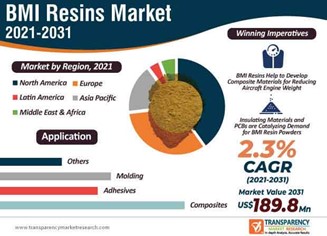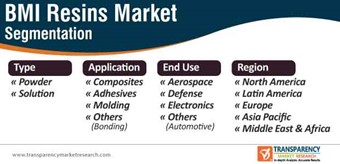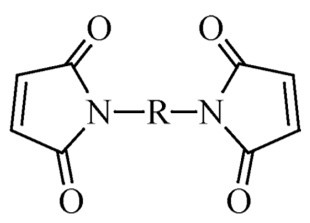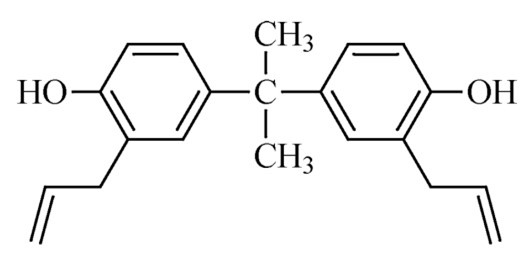Epoxies have been a workhorse in the thermoset industry for decades. They offer a compelling cost/performance benefit in many applications. This blog post series will cover other high performance thermosetting resins such as bismaleimides and cyanate esters. Bismaleimides can be aliphatic such as used in high performance electronic adhesive systems or be aromatic where they are used in composites. Cyanate esters are high Tg materials used in a wide variety of applications from aerospace to electronics. One of the most used substrate materials in electronics is a mixture of epoxy, bismaleimide and cyanate ester called bismaleimide triazine (BT) epoxy. This blog post series will cover chemistry, curing mechanisms, formulation strategies, processing, and touch on some applications of these two classes of high-performance thermosetting chemistries.
BMI Resins Market
The bismaleimide resin markets and applications are shown in Figure 1. The two main applications are aerospace and electronics. Aromatic BMI’s are extensively used in aerospace applications due to their attractive physical properties, notably high Tg. Aromatic bismaleimides are also used in electronic applications such as high Tg printed circuit boards and bismaleimide triazine (BT) epoxy high density interconnect substrates used to electrically connect semiconductor chips.
On the other hand, aliphatic bismaleimides are used in advanced high-performance adhesives used to attach semiconductor chips to various types of substrates. As seen in Figure 1, the compound annual growth rate (CAGR) for bismaleimides is 2.3% between 2021-2031.
Figure 1. BMI resins market, applications, and growth rate (CAGR) [source www.tranparencymarketresearch.com]
Figure 2 shows the market segmentation for bismaleimide resins. Composite applications are used in the defense, aerospace, and electronics end use markets. A small but growing niche is the use of aliphatic (liquid) bismaleimides in adhesives for electronic applications.
Figure 2. Bismaleimide resin market segmentation. [source www.tranparencymarketresearch.com]
Aromatic Bis-maleimides
Bismaleimides are thermosetting polyimides that cure by addition reactions that avoid formation of volatiles. Unlike condensation polyimides (such as DuPont Kapton® or Ube Upilex®) where the polymerization mechanism results in the evolution of volatiles (mainly water) during curing and are typically used as thin films. The bismaleimide resins discussed in this post contain unsaturated double bonds that can be cured via free-radical, Michael addition, or cycloaddition mechanisms, such as Diels–Alder. Thermal polymerization without the resultant evolution of volatile by-products enables bismaleimide resins to be used in a large number of applications from electronic materials (such as die attach adhesives), coatings, films, structural adhesives, encapsulants, and high-performance fiber-reinforced composites.
Bismaleimide resins have the following general structure [reference 1]:
Structure (1)
Depending on the desired properties, the R group can be either aliphatic or aromatic. For high Tg networks, aromatic bismaleimides are used. The most common component in bismaleimide resins is 4,4′bismaleimidodiphenylmethane (BMI) as shown in structure (2).
Structure (2)
The BMI resin is a high melting point crystalline solid and when thermally cured, the resulting networks are very brittle with low fracture toughness. To avoid this drawback, BMI’s are typically formulated with common reactive comonomers such as vinyl and allyl compounds, allyl phenols, aromatic amines to achieve the desired final properties and processing characteristics. Commercially available resin systems are typically two-component systems. For example, the Matrimid 5292 system from Huntsman Chemical (Matrimid 5292 originally developed by Ciba Geigy) is a blend of BMI and o,o′-diallyl bisphenol A (DABA). DABA is shown in Structure 3 below.
Structure (3)
DABA has low viscosity and is used in place of solvents to enhance the processability and increase the toughness of BMI composites. DBA copolymerizes with BMI causing a decrease in the crosslink density, leading to a tougher network. BMI resins for composites are cured at temperatures in the range of 200–250°C.
There are many types of commercially available BMI resin systems. The COMPIMIDE® bismaleimide resins are available from Evonik provide a full range of thermosetting resins that are functionally designed for high-performance composites, typically for applications in the aerospace industry. These resins are characterized by their excellent temperature resistance and high glass transition temperatures, thus providing optimal performance in any environmental condition. Other advantages include preservation of mechanical properties at temperatures up to 250 °C, good resistance to flame and radiation, minimal smoke and toxicant secretions, and simple processing. COMPIMIDE® bismaleimide products include bismaleimide monomers, toughening modifiers, and formulated bismaleimide resins.
COMPIMIDE® bismaleimide matrix resins are characterized by their high glass transition temperature (Tg). They offer improved high temperature performance over epoxies and cyanate esters. Other outstanding features are [3]:
- easy processing by autoclave, platen press, and compression molding techniques,
- retention of excellent mechanical properties up to 250 °C,
- good solvent resistance,
- excellent performance in hot and wet conditions and,
- superior flame and radiation resistance,
- low smoke and toxicant emissions
Typical processing techniques include prepregging (from the melt, solution, or suspension), resin transfer molding (RTM), filament winding, compression molding, powder coating and pultrusion.
The COMPIMIDE® bismaleimide product group comprise COMPIMIDE® Bismaleimide Monomers, Toughening Modifiers and Formulated Bismaleimide Resins.
References
- Horst Stenzenberger, BMI Resin Chemistry, ASM Handbook, Volume 21, Composites p. 97-104, 2001
- J. Iredale, C. Ward, and I. Hamerton, Modern Advances in Bismaleimide Resins Technology, Progress in Polymer Science, 69, (2017) p. 1-21
- Evonik Product Data on COMPIMIDE






Dear Dr. Gotro: Excellent overview of the bismaleimide resin chemistry. Thank you..